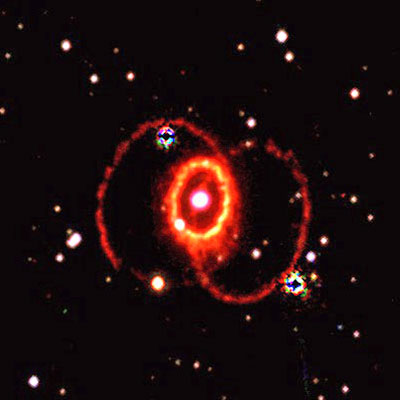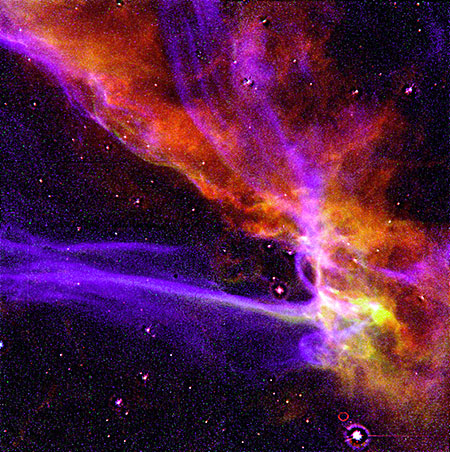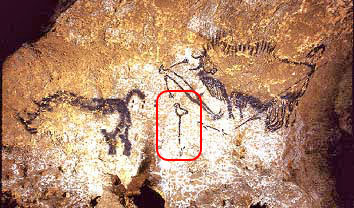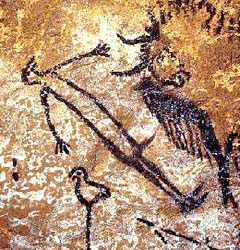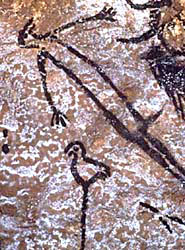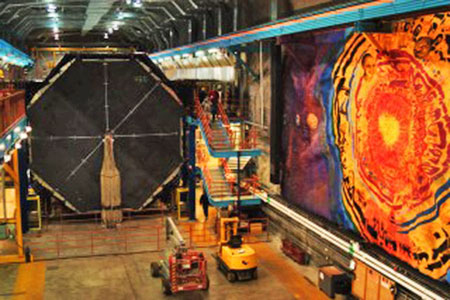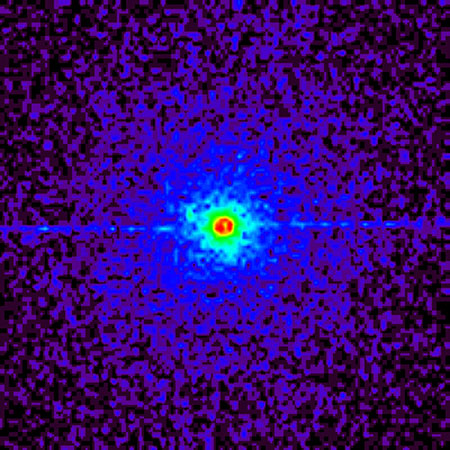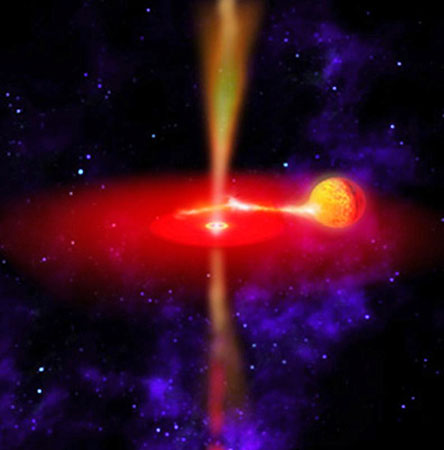|
by Andrew Collins 2006 from AndrewCollins Website
Ever since the discovery in the 1920s that radiation can cause gene mutations, scientists have speculated on the role that high energy cosmic rays might have played in evolution.
Indeed, as early as 1930 it became the
theme of a science-fiction story in which cosmic rays were harnessed
by a mad scientist in order to rapidly transform himself into a
super being millions of years ahead of his time, While similar ideas must have been behind the entrance of the alien black monolith among a community of ape-men in Arthur C. Clarke's classic '2001: A Space Odyssey'.
Moreover, one of the greatest scientific minds of the twentieth century, American astronomer Carl Sagan wrote in 1973 that human evolution was the result of incoming cosmic rays from some distant neutron star, demonstrating how everything in the universe affects everything else.
It was a bold notion, but one destined
not to find favour among geneticists, simply because there was no
hard evidence that cosmic rays - first confirmed during a series of
balloon ascents in 1912 by Austrian physicist Victor F. Hess
(1883-1964) - have any real impact on evolution, whatever their
origin (since there is no consensus on this fact).
He concluded that the cosmic ray flux penetrating the upper atmosphere and reaching ground level was inadequate to explain spontaneous mutations in life forms, whatever their type.
Muller was not wrong, but had he been privy to modern scientific data that clearly demonstrates that at certain times in the Earth's history it has been bombarded with high levels of cosmic rays then he might have thought again.
Many disintegrate in milliseconds, but others with much longer half lives plummet to the ground and are preserved in everything from lake sediments to stalagmites and, more crucially, the ice that forms to great depths in the Arctic and Antarctic regions. One such isotope called Beryllium 10 (10Be) is clearly traceable in ice cores.
Since individual layers of ice form each year the levels of Beryllium 10 can be counted to provide accurate indications of cosmic ray activity in the upper atmosphere.
An examination of its Beryllium-10
content indicates that between 45,000 and 11,000 years ago the Earth
was bombarded by twice the amount of cosmic radiation than it is
today.
Was it really a neutron star, as Carl Sagan suggested, or could it have been another astronomical source such as a black hole, which produces jets of particles that reach out far across galaxies?
Cosmic rays are known to be partially
deflected by the solar magnetic field that stretches out far into
the heart of the solar system, and it is believed that the rate of
Beryllium 10 production in the upper atmosphere is dependent on the
strength of the solar field, which is itself connected with sunspot
activity.
This said, there might easily have been
other factors behind the sudden increase in cosmic rays hitting the
earth, the most catastrophic being a supernova, the death of a star
as it expels the last of its nuclear fuel and collapses to form a
high-mass compact object, either a white dwarf, black hole or
neutron star.
(Credit: NASA/Hubble).
If such an event occurred close enough to our own solar system then the Earth would be showered by deadly radiation, which might damage the ozone layer, causing not only many more rays to reach ground level, but also the onset of high levels of UV radiation from the sun.
More conservatively, catastrophists
suggest that a close supernova would send a barrage of cosmic
particles in our direction, which would dramatically increase cloud
formation, preventing the sun from penetrating through the
atmosphere, and thus bringing about a sudden ice age.
In fact, one wonders whether Sagan's unique view that cosmic rays accelerate human evolution actually stemmed from his obvious fascination with the extinction of the dinosaurs, even though we now know they were not killed off this way.
And such scientific speculation is where it starts getting interesting, for when the high levels of beryllium 10 were first noted in the ice cores at the beginning of the 1990s, scientists from the Cosmic Ray Council of the Soviet Academy of Sciences, working alongside a team from the University of Arizona, speculated that they resulted from a supernova explosion just 150 lights years away.
That's just 900 million, million miles
from here...
the remnant of a supernova
To back up their dramatic claims the
joint Soviet-American team cited the presence at around 150 light
years away in the northern constellation of Cygnus of an immense
formation of glowing clouds of gaseous debris - the remnants of an
immense supernova explosion - known to astronomers as the Cygnus
Veil, or Veil nebula.
Yet, thankfully, there was one person who did take notice, and this was British anthropological writer Denis Montgomery.
Having lived in Africa for many years, where anatomically modern humans emerged for the first time some 200,000 years ago, he became intrigued as to why sudden jumps of evolution occur.
Was it purely spontaneous, through chemical changes in the body, or were there other exterior factors at play, such as environmental and climatic changes, nutritional variety or even simple competitiveness?
For instance, around 80,000 years ago the peoples of the republic of Congo were making barbed bone hooks for fishing, while a community that inhabited a large cave called Blombos on the southern coast of South Africa would seem to have fashioned the earliest known examples of expressive art.
These take the form of incised pieces of red ochre rock, showing cross-hatching designs, as well as perforated snail shell beads, once strung on a cord and worn either as a necklace or bracelet.
All of these invaluable objects are thought to be around 75,000 years old.
At a time coincident to when homo
sapiens first entered a Europe dominated until this time by the
Neanderthal folk, there is clear evidence for the adoption of a
complex life style, the earliest known to human kind.
Dating to some 35,000 years before the
present time, they contain images and sculptures of whole menageries
of wild animals, including horses, rhinos, lions, mammoths and
bison, alongside abstract representations of the human form
extenuated, or brought to life, by the rock face itself.
This trend ended finally around 11,000 years ago when the Upper Paleolithic age climaxed coincident to the cessation of the last Ice Age.
This in turn might have brought about
the enlightened age of the cave artist in Western Europe. It could
also explain why the Neanderthal peoples suddenly became extinct
around this time, perhaps as a result of too much competition from
their competitive new neighbors, the homo sapiens.
Adding to his problems was the realization by astronomers during the mid 1990s that the Cygnus Veil, the nebula at the centre of what Montgomery came to refer to as 'the Cygnus event', was found to be not 150 light years away from the Earth, as had previously been thought, but in fact around 1,800 light years away.
This meant that from here the supernova explosion would have been little more than a bright light source in the northern sky lasting for a period of several days, before gradually dying away.
Doubly damning were recalculations concerning the age of the supernova event, which now appears to have occurred as recently as 5,000-8000 years ago (even though some astronomical sources still reckon it took place much earlier, perhaps 10,000-15,000 years ago).
Thus there was no way that the Cygnus
Veil can have been responsible for the high levels of cosmic rays
reaching Earth's atmosphere when the first cave artists created
underworld Sistern Chapels like Chauvet around 35,000 years ago.
At the conference of TAG (the Theoretical Archaeological Group) in Sheffield, England, held in December that year, Dr Aden Meinel - a retired veteran of NASA's Jet Propulsion Laboratory, who in the 1980s was responsible for the launch of space telescopes such as Hubble - told a packed audience of bemused archaeologists and students that he and his colleagues at the Meinel Institute in Pasadena, California, had determined that the high levels of Beryllium 10 in the Greenland and Antarctica ice cores were responsible for sudden changes in evolution in both animal and human life around 40,000-35,000 years ago.
This the Meinel group saw as the remnants of what was once a galactic binary system consisting of a super giant and an active black hole spewing out jets of plasma, or ionized gas at velocities close to the speed of light.
These, he proposed, had crossed thousands of light years of space to reach the earth around 40,000 to 35,000 years ago, causing the changes in evolution witnessed at this time.
My own research into the emergence of primitive societies, with their own unique cosmologies and religion, ha revealed an inordinate interest in one particular constellation - Cygnus, the celestial swan. Indeed, it features as the oldest known artistic representation of a constellation anywhere in the world, for it is seen on the walls of the famous Lascaux cave in southern France, which is known to have first been occupied around 17,000 years ago.
It is the same story with ancient stone and earthen structures worldwide, from the bird effigy mounds of North America to,
...to Avebury, the largest stone circle
in Europe - all seem to reflect an age-old interest in Cygnus, which
features also at the heart of religious symbolism worldwide,
including that of
Judaism, Christianity, Hinduism, Islam
and more primitive forms of shamanism.
In the knowledge that the work of South African anthropologist and rock art specialist David Lewis-Williams had determined that much prehistoric cave art was inspired by shamans in mind-altered states, I wondered whether the stars of Cygnus had come to be seen as the source of a primeval being, thought to have been responsible for cosmic life and death.
Moreover, did the peoples of the Upper Paleolithic come to associate this primeval cause with religious experiences deep underground, where their most sacred cave art was executed?
If so, then why did they come to
associate a specific star constellation with the deepest part of
caves?
in Minnesota
(Pic credit: Soudan)
They bore the distinctive 'fingerprint' of a strange binary system containing a black hole or neutron star known as Cygnus X-3.
The existence of these high energy
cosmic particles caused immediate controversy, since they matched
the characteristics of no known particle.
Scientists have long been aware that when cosmic rays disintegrate they produce what is known as Cherenkov radiation, which appears as an objective burst of light as it passes through the water of the eye.
Did the Paleolithic shamans deep underground come to identify similar light bursts caused by cosmic rays from Cygnus X-3 as part of some religious experience, centered on the Cygnus constellation?
Moreover, did the high levels of cosmic
rays that affected the world in Paleolithic times come from the
direction of Cygnus, explaining why it can be found at the heart of
religious symbolism worldwide?
(Pic credit
NASA/Chandra X-ray Observatory ACIS/HETG).
Unfortunately, astrophysicists are
unanimous in their opinion that the Cat's Eye is a wimpy object
unable to produce cosmic rays that might reach the Earth.
Artist's impression of a black hole/neutron star binary system like Cygnus X-3 (Pic credit: NASA).
Today there can be little doubt that
Cygnus X-3, as a neutron star/black hole as well as the galaxy's
first confirmed blazar, is the best candidate by far for at least a
proportion of the cosmic radiation responsible for the acceleration
of human evolution at a time when we were just beginning to emerge
as modern human beings.
It has burst into action three times
already this year, yet astronomers are waiting for what they see as
the 'next big bang', showers of cosmic particles on a level never
seen before, and when this happens, who knows, we might well be
ready for the next stage in evolution.
|

